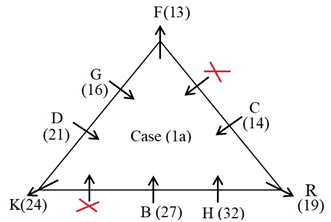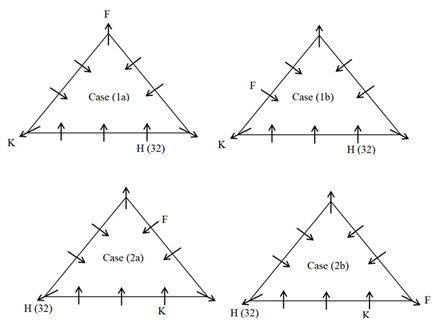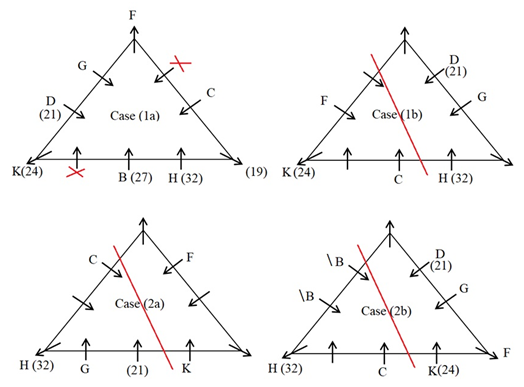Dear Aspirants, Our IBPS Guide team is providing new series of Reasoning Questions for IBPS Clerk Mains 2021 so the aspirants can practice it on a daily basis. These questions are framed by our skilled experts after understanding your needs thoroughly. Aspirants can practice these new series questions daily to familiarize with the exact exam pattern and make your preparation effective.
Triangular seating arrangement
Direction (1-5): Study the following information carefully and answer the questions below.
Eight people are sitting at a triangular table. There is 1 chair placed at each corner, 3 chairs are kept on one edge and 2 chairs each are kept on the remaining two edges. The persons on the corner of the table are facing away from the center and the persons on the edge of the table are facing the center. Each person likes a different number of viz. 13, 14, 16, 19, 21, 24, 27 and 32.No two adjacent chairs are vacant.
Note: Facing opposite direction means if one person faces the center then the other faces away from the center and vice versa.
F, who likes prime number, sits four places away from the one who likes 32. C sits fourth to the left of the one who likes 21, who sits on the immediate right of G. K, who likes even number, sits third to the left of the one who likes 32. C neither sits at any corner nor sits adjacent to F. G neither sits adjacent to the one who likes 24 nor sits at the corner of the table. G doesn’t sit adjacent to the one who likes 32. The one who likes 21 doesn’t sit at the corner of the table. The sum of the numbers liked by F and C is equal to the number liked by B. The one who likes 21 neither sits adjacent to F nor sits adjacent to H. Two persons sit between R and the one who likes a number which is a perfect square. H, who likes 32, sits facing opposite direction to that of K. Sum of numbers liked by B and D is twice the number liked by K. One person sits between D and B, who neither sits adjacent to F nor sits at the corner. B sits second to the right of the one who likes 19.
1) What is the position of H with respect to the one who likes 27?
A. Immediate right
B. Second to the left
C. Third to the right
D. Second to the right
E. None of these
2) Who among the following person likes 19?
A.B
B.R
C.F
D.G
E. None of these
3) How many persons sit between G and the one who likes 24 when counted from the right of G?
A.3
B.2
C.4
D.1
E. None
4) Which of the following statement is not true?
A. Two persons sit between the one who likes 14 and D.
B.D sits on the immediate right of the one who likes 16.
C.F sits on the immediate right of B.
D. Two persons sit between K and the one who likes 19.
E. All the above statements are true.
5) What is the sum of the number liked by B, D and G?
A.83
B.61
C.64
D.46
E. None of these
Coding decoding
Direction (6-10): Study the following information carefully and answer the questions given below.
In a certain code language,
‘Trial income detect official’ is coded as ‘5DJ* 18FU* 10J+ 6PD*’
‘Collection available introduce’ is coded as ‘13DF* 6M+ 6P+’
‘Delivery import abroad’ is coded as ‘23WJ* 13PQ* 5PS*’
‘Campaign filing decision’ is coded as ‘3JM* 13BQ* 12TJ*’
6) How is ‘sand stock’ written in this code language?
A.17B* 10P*
B.17OB* 9P*
C.17OB+ 10P+
D.17OB* 10P+
E. None of these
7) How is ‘agitation owner’ written in this code language?
A.5O+ 5B+
B.5O* 15B+
C.5O+ 15B+
D.5B* 5OP+
E. None of these
8) Which of the following word is written as ‘13J+’?
A. delivery
B. communication
C. interpretation
D. Fund
E. None of these
9) Symbol represents which of the following in this code language?
A. Number of vowels count in a word
B. Number of consonants count in a word
C. Difference between the first and last letter is odd or even
D. Number of letters count in a word which is even or odd
E. None of these
10) What is the code for ‘issue’?
A.6T*
B.5Y+
C.6T+
D.5BU*
E. None of these
Answers :

We have:
- K, who likes even number, sits third to the left of the one who likes 32.
- H, who likes 32, sits facing opposite direction to that of K.
That means, in case (1) K sits on the corner, in case (2) H sits at the corner.
- F, who likes prime number, sits four places away from the one who likes 32.
That means, in case (1a) & case (2a) F sits fourth to the right of H, in case (1b) & case (2b) F sits fourth to the left of H.
Based on the above given information we have:

Again, we have:
- C neither sits at any corner nor sits adjacent to F.
- C sits fourth to the left of the one who likes 21, who sits on the immediate right of G.
- G neither sits adjacent to the one who likes 24 nor sits at the corner of the table.
- The one who likes 21 neither sits adjacent to F nor sits adjacent to H.
- G doesn’t sit adjacent to the one who likes 32.
- The one who likes 21 doesn’t sit at the corner of the table.
Since K doesn’t like an odd number, thus in case (1a) C sits second to the right of H, in case (1b) C sits on the immediate left of H, in case (2b) C sits on the immediate left of K, case (2a) is not valid.
- The Sum of numbers liked by B and D is twice the number liked by K.
Since, only such combinations are (13, 19, 16), (14, 24, 19), (27, 21, 24) & (32, 16, 24).
- The Sum of the numbers liked by F and C is equal to the number liked by B.
Since, only such combinations are (13, 14, 27) & (13, 19, 32).
Also, we clearly, know that H likes 32, thus B must like 27.
Thus, D must like 21 and K likes 24.
- One person sits between D and B, who neither sits adjacent to F nor sits at the corner.
- B sits second to the right of the one who likes 19.
That means, in case (1a) B sits on the immediate left of H, case (1b) & case (2b) are not valid.
Based on the above given information we have:

Case 1(b) gets eliminated as one person sits between D and B, who neither sits adjacent to F nor sits at the corner.
Case 2(a) will get eliminated as G doesn’t sit adjacent to the one who likes 32.
Case 2(b) will get eliminated as B sits second to the right of the one who likes 19. 19 cannot be placed anywhere in case 2(b). So it will get eliminated.
Again, we have:
Since, F likes prime number, thus the only remaining prime number is 13.
- Two persons sit between R and the one who likes a number which is a perfect square.
That means, R must like 19 and G likes 16.
Since, the only remaining number is 14, thus C likes 14.
Based on the above given information we have final arrangements as follows:

1) Answer: A
2) Answer: B
3) Answer: D
4) Answer: C
5) Answer: C
Directions (6-10):
The number represents the difference between the place value of the first and last letter of the given word as per alphabetical series+2.
Letter represents,
If the number of letter count is odd, then middle letter+1in the alphabetical series
Example:
Trial -> here the number of letters is odd,
Middle letter -> I+1=J
Else
If Even, interchange the position of two middle letters+1 in the alphabetical series
Example:
Income -> Here the number of letters is even,
Middle letters -> CO -> OC (Interchanging the middle letters) +1=PD
Symbol represents,
If the number of letters is odd, then code it as +, else code it as *.
6) Answer: D
7) Answer: C
8) Answer: B
9) Answer: D
10) Answer: C





